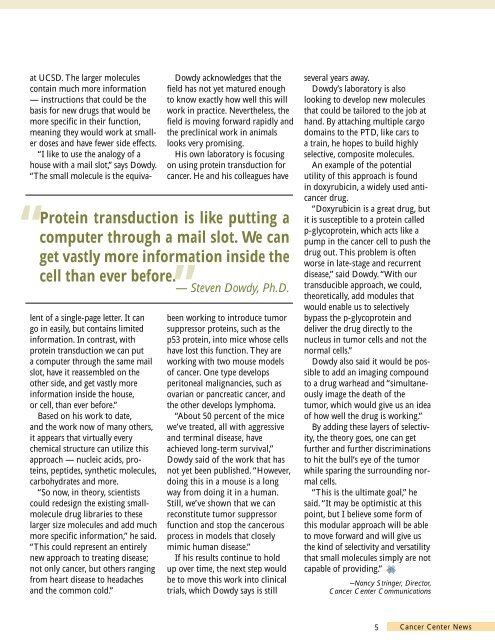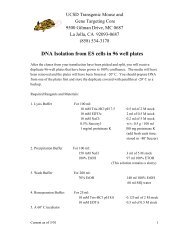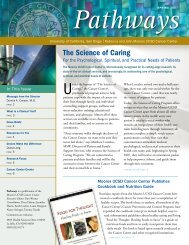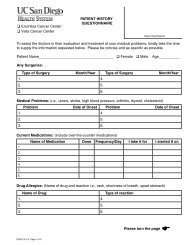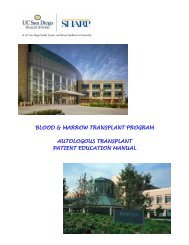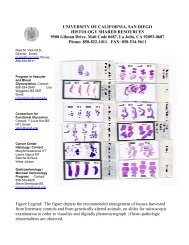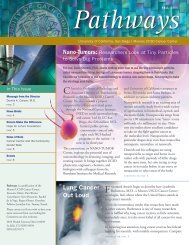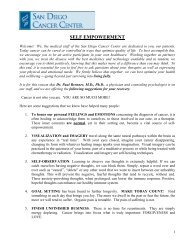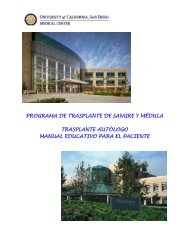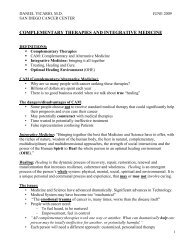PROTEIN TRANSDUCTION: - Moores Cancer Center
PROTEIN TRANSDUCTION: - Moores Cancer Center
PROTEIN TRANSDUCTION: - Moores Cancer Center
Create successful ePaper yourself
Turn your PDF publications into a flip-book with our unique Google optimized e-Paper software.
“<br />
at UCSD. The larger molecules<br />
contain much more information<br />
— instructions that could be the<br />
basis for new drugs that would be<br />
more specific in their function,<br />
meaning they would work at smaller<br />
doses and have fewer side effects.<br />
“I like to use the analogy of a<br />
house with a mail slot,” says Dowdy.<br />
“The small molecule is the equivalent<br />
of a single-page letter. It can<br />
go in easily, but contains limited<br />
information. In contrast, with<br />
protein transduction we can put<br />
a computer through the same mail<br />
slot, have it reassembled on the<br />
other side, and get vastly more<br />
information inside the house,<br />
or cell, than ever before.”<br />
Based on his work to date,<br />
and the work now of many others,<br />
it appears that virtually every<br />
chemical structure can utilize this<br />
approach — nucleic acids, proteins,<br />
peptides, synthetic molecules,<br />
carbohydrates and more.<br />
“So now, in theory, scientists<br />
could redesign the existing smallmolecule<br />
drug libraries to these<br />
larger size molecules and add much<br />
more specific information,” he said.<br />
“This could represent an entirely<br />
new approach to treating disease;<br />
not only cancer, but others ranging<br />
from heart disease to headaches<br />
and the common cold.”<br />
Dowdy acknowledges that the<br />
field has not yet matured enough<br />
to know exactly how well this will<br />
work in practice. Nevertheless, the<br />
field is moving forward rapidly and<br />
the preclinical work in animals<br />
looks very promising.<br />
His own laboratory is focusing<br />
on using protein transduction for<br />
cancer. He and his colleagues have<br />
Protein transduction is like putting a<br />
computer through a mail slot. We can<br />
get vastly more information inside the<br />
cell than ever before.<br />
— Steven Dowdy, Ph.D.<br />
”<br />
been working to introduce tumor<br />
suppressor proteins, such as the<br />
p53 protein, into mice whose cells<br />
have lost this function. They are<br />
working with two mouse models<br />
of cancer. One type develops<br />
peritoneal malignancies, such as<br />
ovarian or pancreatic cancer, and<br />
the other develops lymphoma.<br />
“About 50 percent of the mice<br />
we’ve treated, all with aggressive<br />
and terminal disease, have<br />
achieved long-term survival,”<br />
Dowdy said of the work that has<br />
not yet been published. “However,<br />
doing this in a mouse is a long<br />
way from doing it in a human.<br />
Still, we’ve shown that we can<br />
reconstitute tumor suppressor<br />
function and stop the cancerous<br />
process in models that closely<br />
mimic human disease.”<br />
If his results continue to hold<br />
up over time, the next step would<br />
be to move this work into clinical<br />
trials, which Dowdy says is still<br />
several years away.<br />
Dowdy’s laboratory is also<br />
looking to develop new molecules<br />
that could be tailored to the job at<br />
hand. By attaching multiple cargo<br />
domains to the PTD, like cars to<br />
a train, he hopes to build highly<br />
selective, composite molecules.<br />
An example of the potential<br />
utility of this approach is found<br />
in doxyrubicin, a widely used anticancer<br />
drug.<br />
“Doxyrubicin is a great drug, but<br />
it is susceptible to a protein called<br />
p-glycoprotein, which acts like a<br />
pump in the cancer cell to push the<br />
drug out. This problem is often<br />
worse in late-stage and recurrent<br />
disease,” said Dowdy. “With our<br />
transducible approach, we could,<br />
theoretically, add modules that<br />
would enable us to selectively<br />
bypass the p-glycoprotein and<br />
deliver the drug directly to the<br />
nucleus in tumor cells and not the<br />
normal cells.”<br />
Dowdy also said it would be possible<br />
to add an imaging compound<br />
to a drug warhead and “simultaneously<br />
image the death of the<br />
tumor, which would give us an idea<br />
of how well the drug is working.”<br />
By adding these layers of selectivity,<br />
the theory goes, one can get<br />
further and further discriminations<br />
to hit the bull’s eye of the tumor<br />
while sparing the surrounding normal<br />
cells.<br />
“This is the ultimate goal,” he<br />
said. “It may be optimistic at this<br />
point, but I believe some form of<br />
this modular approach will be able<br />
to move forward and will give us<br />
the kind of selectivity and versatility<br />
that small molecules simply are not<br />
capable of providing.”<br />
—Nancy Stringer, Director,<br />
<strong>Cancer</strong> <strong>Center</strong> Communications<br />
5<br />
<strong>Cancer</strong> <strong>Center</strong> News


